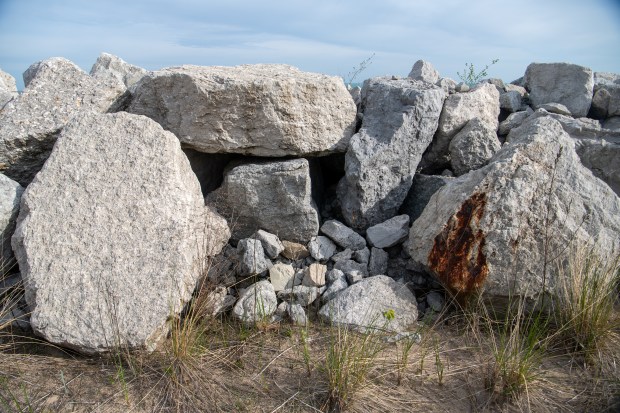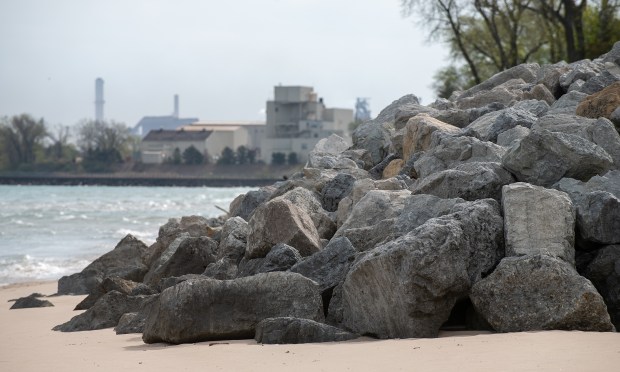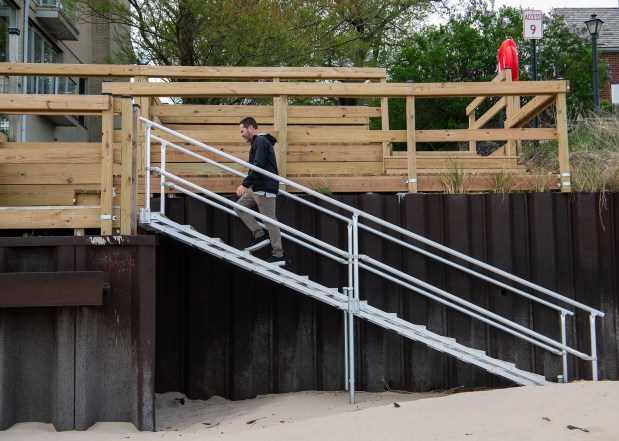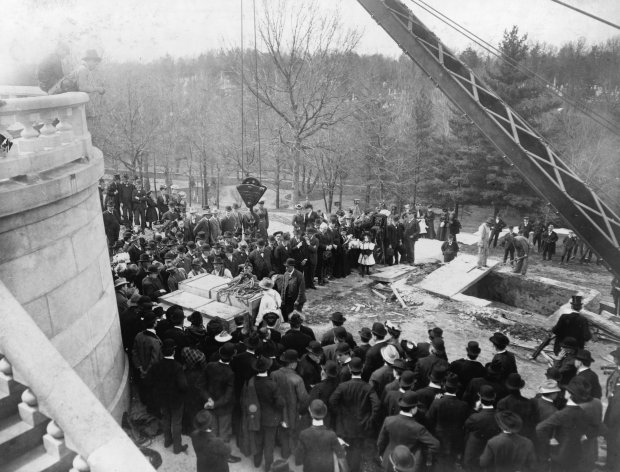When Ogden Dunes began hardening the shoreline against Lake Michigan’s attacks, Save the Dunes drew a line in the sand. So did the Indiana Department of Natural Resources. So did the U.S. Coast Guard.
And now it’s up to the Indiana Natural Resources Commission to figure out which of the lines matters most as it weighs the town’s desire to protect homes and infrastructure and Save the Dunes’ interest in protecting public access to the beach.
In 2020, when the lake level was high, the tiny town of 1,167 people declared an emergency and reinforced the shoreline with boulders weighing one to five tons each. Waves were washing away the steel wall that had been installed to protect the town.
“It was overtopping the pilings at this point right here,” Town Council President Scott Kingan said as he stood on the 20-foot easement between the homes and the lake at the northeast corner of the town.
He gestured toward a multimillion-dollar house visible from Indiana Dunes National Park. “They had contractors coming out and giving estimates on demoing homes,” Kingan said. The owners were days away from making a painful decision when the town acted to reinforce the shoreline.
It cost $10 million to protect the homes, with homeowners kicking up to $500,000 each to pay for it, Kingan said. The current project is $2 million, much cheaper because it’s not being done in crisis mode.
Now, with the lake level low, the town wants to continue the project, to resume for a second phase. Contractor G.E. Marshall of Valparaiso had just begun placing rocks when Save the Dunes and the Conservation Law Center obtained a preliminary injunction to stop the work.
“This is a very difficult, intractable problem,” said environmental attorney Kim Ferraro, representing Save the Dunes in this case.
“The Department of Natural Resources approved the permit without delineating the boundary between private property and the public beach,” she said.
For people along Indiana’s Lake Michigan shoreline, it’s a familiar battle.
In the Gunderson v. State case, some homeowners in Long Beach argued that their property extended to the water’s edge. Not so, said Save the Dunes. In 2018, the Indiana Supreme Court ruled beaches below the ordinary high-water mark are public beaches.
But where is that mark? That’s the line in the sand that is the source of the current battle between Ogden Dunes and Save the Dunes.
After the Supreme Court ruling, the Indiana General Assembly tasked the DNR with protecting the public’s access to the beach.
“The public trust doctrine goes back to the nation’s founding,” Ferraro said. When Indiana became a state in 1816, the federal government ceded waters and more for Indiana to protect the public trust for boating, swimming, fishing and other uses.
Ferraro accused the DNR of failing to delineate the ordinary high water mark. “Why did we spend six years fighting Gunderson for DNR not to protect the land that belongs to the public?”

Nerd alert: The number 581.5 is at issue here. That’s the number of feet the International Great Lakes Datum of 1985 used to measure water levels in the Great Lakes and the St. Lawrence River basin. In Indiana’s case, that’s the ordinary high-water mark to show the highest Lake Michigan water level expected in the area.
Kingan said the U.S. Army Corps of Engineers and the state came out to place flags along the shoreline. It appeared the ordinary high-water mark was about where gentle waves now caress the beach or maybe even further north into the lake, he was told.
“From the town’s perspective, we didn’t do anything wrong,” Kingan said.
In 2020, when Ogden Dunes received an emergency DNR permit for the first phase of revetment on the east end of town, where the erosion was worst, lake levels were extremely high. “The water levels are low so there’s no emergency right now,” Save the Dunes Executive Director Betsy Maher said.
Understanding the cause of the erosion requires knowledge of Lake Michigan’s mechanics. Sand travels from east to west along the southern edge of the lake. That’s how beaches are replenished.
Even as Save the Dunes and Ogden Dunes tussle over the revetment issue and protecting public access to the beach, they both point to the cause of the erosion – large manmade structures that extend north into the lake, blocking the natural flow of sand. In Ogden Dunes’ case, it’s the Port of Indiana in Portage.
A manmade structure traps flow on the east side of the structure and starves the west side.
At Indiana Dunes National Park’s Portage Lakefront and Riverwalk along Burns Waterway, a foredune was washed away by Lake Michigan when the lake level was high, causing the National Park Service and Portage Street Department to cooperate in placing large rocks at the shoreline to protect the pavilion and other infrastructure at that unit of the national park.
The federal government, like Ogden Dunes, needed to harden the shoreline to protect important infrastructure, Kingan said.

He’s concerned about what will happen if the state expands the port to accommodate more ship traffic. Kingan, who runs a sailing school in Michigan City, understands the benefits of additional business that comes from expanding ship access to Northwest Indiana. But he also wonders what the environmental impact could be.
Dredging could provide the sand for what’s called beach nourishment. Sand dredged from the bottom of the lake is dumped offshore so it can feed beaches to the west. That’s a process by which Mount Baldy, at the national park’s eastern edge, is fed.
The pier at Michigan City, like the one at the Port of Indiana, blocks the flow of sand. The Sheridan Beach area and Washington Park east of the lighthouse have grown over the decades since the pier was built.
The Port of Indiana was developed in the 1960s, part of the compromise that ultimately led to the creation of Indiana Dunes National Park, then Indiana Dunes National Lakeshore, in 1966.
Back then, engineers understood what would happen to the flow of sand when the port was built. “There’s documented evidence that they knew there would be a disruption to the sand, which would cause erosion,” Maher said.
Ogden Dunes has a long history of lawsuits over this. When the town was developed 100 years ago, erosion wasn’t an issue. For the last half a century or more, erosion has been a major concern.
Kingan predicted that five years ago, if the town hadn’t hardened the shoreline, it could have lost two rows of homes, Shore Drive, septic tanks and more. “If we hadn’t done anything, we probably would have had a pretty major environmental disaster,” he said.

The state and Corps of Engineers worked together to build the port, but the federal government didn’t want any liability for the environmental consequences, Maher said, and left that to the state to deal with.
“We all know exactly what the solution is, and it’s more sand,” Kingan said – to the tune of 200,000 cubic yards of sand each year. “These solutions are just in the tens of millions of dollars,” plus annual maintenance, which is why the town continues to fight for a long-term solution, he said.
In one settlement with the port, the town received money to buy a dredge but used the money to file another lawsuit instead, Maher said. “They haven’t had clean hands, but hindsight is 20/20,” she said.
“It’s an unfortunate situation in Ogden Dunes, where they suffered so much erosion,” but it’s a living shoreline, Maher said. “Our greatest state resource,” she said, is Lake Michigan’s shoreline. It’s why Northwest Indiana is so populous and a major portion of Indiana’s economy.
Hardening the shoreline makes beaches go away, Maher said.
Kingan pointed to sand piling up in front of the rocks placed in the first phase of the revetment effort as evidence that sand will return.
The town plans to place more sand and plant native grasses to help keep it in place as part of the second phase, he said.
In addition, the town is adding access points and stairs to improve public access to the beach, Kingan said. “Public access has not gone away. I would argue we have increased public access.”
In just a few weeks, the Indiana Natural Resources Council will take up the issue, drawing its own line in the sand to determine whether the revetment project will continue and under what conditions.
Doug Ross is a freelance reporter for the Post-Tribune.





